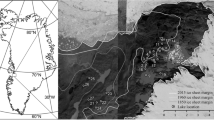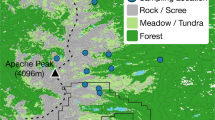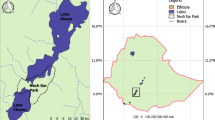Abstract
High mountain lakes provide essential ecosystem services and have a high conservation value. Therefore, understanding how glacier retreat will affect their ecological functioning and water quality is crucial. Here, we tested how shallow high mountain lakes having different glacial influences differ in their abiotic main features and food web structure using a multiple ecological indicator approach. We identified 13 functional groups within the planktonic and littoral communities, each one representing a biotic indicator and a node in a simplified food web network. The abiotic environment and most functional groups differed significantly as a consequence of the glacial influence. In general, runoff from glacial meltwaters resulted in highly simplified food webs. Considering that many turbid glacially fed lakes are losing their hydrological connection with disappearing/retreating glaciers and shifting to a clear state, our results suggest that this shift could enhance food web complexity, but at the cost of losing specific habitats. Further, retreat of large glaciers will form new glacially fed lakes, but it remains unclear whether this will buffer the expected habitat and biodiversity loss.




Similar content being viewed by others
References
Anesio AM, Hodson AJ, Fritz A, Psenner R, Sattler B. 2009. High microbial activity on glaciers: importance to the global carbon cycle. Glob Change Biol 15:955–60.
APHA, Awwa, WEF. 2012. Standard methods for examination of water and wastewater. Waashington: American Public Health Association.
Barta B, Mouillet C, Espinosa R, Andino P, Jacobsen D, Christoffersen KS. 2018. Glacial-fed and páramo lake ecosystems in the tropical high Andes. Hydrobiologia 813:19–32.
Barton K. 2011. MuMIn: multi-model inference. R package v. 1.6. 5.
Bettinetti R, Quadroni S, Galassi S, Bacchetta R, Bonardi L, Vailati G. 2008. Is meltwater from Alpine glaciers a secondary DDT source for lakes? Chemosphere 73:1027–31.
Braioni MG, Gelmini D. 1983. Rotiferi Monogononti (Rotatoria: Monogononta). Guide per il riconoscimento delle specie animali delle acque interne italiane. Italy: Consiglio Nazionale delle Ricerche.
Callieri C. 2017. Synechococcus plasticity under environmental changes. FEMS Microbiol Lett 364:fnx229.
Callieri C, Morabito G, Huot Y, Neale PJ, Litchman E. 2001. Photosynthetic response of pico-and nanoplanktonic algae to UVB, UVA and PAR in a high mountain lake. Aquat Sci 63:286–93.
Callieri C, Amalfitano S, Corno G, Bertoni R. 2016. Grazing-induced Synechococcus microcolony formation: experimental insights from two freshwater phylotypes. FEMS Microbiol Ecol 92:fiw154.
Campaioli S, Ghetti PF, Minelli A. 1994. Manuale per il riconoscimento dei macroinvertebrati delle acque dolci italiane. Italy: Provincia autonoma di Trento.
Carrivick JL, Tweed FS. 2013. Proglacial lakes: character, behaviour and geological importance. Quat Sci Rev 78:34–52.
Cauvy-Fraunié S, Andino P, Espinosa R, Calvez R, Jacobsen D, Dangles O. 2016. Ecological responses to experimental glacier-runoff reduction in alpine rivers. Nat Commun 7:12025.
Chillrud SN, Pedrozo FL, Temporetti PF, Planas HF, Froelich PN. 1994. Chemical weathering of phosphate and germanium in glacial meltwater streams: effects of subglacial pyrite oxidation. Limnol Oceanogr 39:1130–40.
Crump ML, Scott NJ. 1994. Visual encounter surveys. In: Heyer WR, Donnelly MA, McDiarmid RW, Hayek LC, Foster MS, Eds. Measuring and monitoring biological diversity: standard methods for amphibians. Washington: Smithsonian Institution Press. p 84–92.
Einsle U. 1996. Copepoda: Cyclopoida: Genera Cyclops, Megacyclops, Acanthocyclops (No. 595.34 EIN). Amsterdam: SPB Academic Pub.
Farinotti D, Usselmann S, Huss M, Bauder A, Funk M. 2012. Runoff evolution in the Swiss Alps: projections for selected high-alpine catchments based on ENSEMBLES scenarios. Hydrol Process 26:1909–24.
Farinotti D, Huss M, Fürst JJ, Landmann J, Machguth H, Maussion F, Pandit A. 2019. A consensus estimate for the ice thickness distribution of all glaciers on Earth. Nat Geosci 12:168–73.
Gauzens B, Legendre S, Lazzaro X, Lacroix G. 2013. Food-web aggregation, methodological and functional issues. Oikos 122:1606–15.
Grueber CE, Nakagawa S, Laws RJ, Jamieson IG. 2011. Multimodel inference in ecology and evolution: challenges and solutions. J Evol Biol 24:699–711.
Helbling EW, Villafañe VE, Barbieri ES. 2001. Sensitivity of winter phytoplankton communities from Andean lakes to artificial ultraviolet-B radiation. Rev Chil Hist Nat 74:273–82.
Haeberli W, Hoelzle M, Paul F, Zemp M. 2007. Integrated monitoring of mountain glaciers as key indicators of global climate change: the European Alps. Ann Glaciol 46:150–60.
Hodson A, Mumford P, Lister D. 2004. Suspended sediment and phosphorus in proglacial rivers: bioavailability and potential impacts upon the P status of ice marginal receiving waters. Hydrol Process 18:2409–22.
Huss M, Hock R. 2018. Global-scale hydrological response to future glacier mass loss. Nat Clim Change 8:135.
Huss M, Bookhagen B, Huggel C, Jacobsen D, Bradley RS, Clague JJ, Vuille M, Buytaert W, Cayan DR, Greenwood G, Mark BG, Milner AM, Weingartner R, Winde M. 2017. Toward mountains without permanent snow and ice. Earth’s Future 5:418–35.
IPCC. 2013. Climate change 2013: the physical science basis. Contribution of working group I to the fifth assessment report of the Intergovernmental Panel on Climate Change. Cambridge: Cambridge University Press.
Jacobsen D, Milner AM, Brown LE, Dangles O. 2012. Biodiversity under threat in glacier-fed river systems. Nat Clim Change 2:361.
Kammerlander B, Koinig KA, Rott E, Sommaruga R, Tartarotti B, Trattner F, Sonntag B. 2016. Ciliate community structure and interactions within the planktonic food web in two alpine lakes of contrasting transparency. Freshw Biol 61:1950–65.
Khamis K, Hannah DM, Brown LE, Tiberti R, Milner AM. 2014. The use of invertebrates as indicators of environmental change in alpine rivers and lakes. Sci Total Environ 493:1242–54.
Knapp RA, Matthews KR, Sarnelle O. 2001. Resistance and resilience of alpine lake fauna to fish introductions. Ecol Monogr 71:401–21.
Koenings JP, Burkett RD, Edmundson JM. 1990. The exclusion of limnetic cladocera from turbid glacier-meltwater lakes. Ecology 71:57–67.
Linsbauer A, Paul F, Haeberli W. 2012. Modeling glacier thickness distribution and bed topography over entire mountain ranges with GlabTop: application of a fast and robust approach. J Geophys Res Earth Surf 117:F3.
Margaritora F. 1985. Fauna d’Italia. Cladocera. Bologna: Edizioni Calderini. p 400p.
Mez K, Hanselmann K, Preisig HR. 1998. Environmental conditions in high mountain lakes containing toxic benthic cyanobacteria. Hydrobiologia 368:1–15.
Milner AM, Khamis K, Battin TJ, Brittain JE, Barrand NE, Füreder L et al. 2017. Glacier shrinkage driving global changes in downstream systems. Proc Natl Acad Sci 114:9770–8.
Mindl B, Anesio AM, Meirer K, Hodson AH, Laybourn-Parry J, Sommaruga R, Sattler B. 2007. Factors influencing bacterial dynamics along a transect from supraglacial runoff to proglacial lakes of a high Arctic glacier. FEMS Microbiol Ecol 59:307–17.
Notarnicola C, Duguay M, Moelg N, Schellenberger T, Tetzlaff A, Monsorno R, Costa A, Steurer C, Zebisch M. 2013a. Snow cover maps from MODIS images at 250 m resolution, part 1: algorithm description. Remote Sens 5:110–26.
Notarnicola C, Duguay M, Moelg N, Schellenberger T, Tetzlaff A, Monsorno R, Costa A, Steurer C, Zebisch M. 2013b. Snow cover maps from MODIS images at 250 m resolution, part 2: validation. Remote Sens 5:1568–87.
Peter H, Sommaruga R. 2016. Shifts in diversity and function of lake bacterial communities upon glacier retreat. ISME J 10:1545.
Pimm SL. 2002. Food webs. Chicago: The University of Chicago Press.
Porter KG, Feig YS. 1980. The use of DAPI for identifying and counting aquatic microflora 1. Limnol Oceanogr 25:943–8.
Porter KG. 1996. Integrating the microbial loop and the classic food chain into a realistic planktonic food web. In: Polis GA, Winemiller KO, Eds. Food webs. Boston: Springer. p 51–9.
Sánchez-Hernández J, Cobo F, Amundsen PA. 2015. Food web topology in high mountain lakes. PloS One 10:e0143016.
Saros JE, Rose KC, Clow DW, Stephens VC, Nurse AB, Arnett HA, Stone JR, Williamson CE, Wolfe AP. 2010. Melting alpine glaciers enrich high-elevation lakes with reactive nitrogen. Environ Sci Technol 44:4891–6.
Schmidt-Kloiber A, Hering D. 2015. www.freshwaterecology.info—an online tool that unifies, standardises and codifies more than 20,000 European freshwater organisms and their ecological preferences. Ecol Indic 53:271–82.
Schmidt-Kloiber A, Hering D. 2018. www.freshwaterecology.info—the taxa and autecology database for freshwater organisms, version 7.0. Accessed 18 Apr 2018.
Slemmons KE, Saros JE. 2012. Implications of nitrogen-rich glacial meltwater for phytoplankton diversity and productivity in alpine lakes. Limnol Oceanogr 57:1651–63.
Slemmons KE, Saros JE, Simon K. 2013. The influence of glacial meltwater on alpine aquatic ecosystems: a review. Environ Sci Process Impacts 15:1794–806.
Sommaruga R. 2015. When glaciers and ice sheets melt: consequences for planktonic organisms. J Plankton Res 37:509–18.
Sommaruga R, Kandolf G. 2014. Negative consequences of glacial turbidity for the survival of freshwater planktonic heterotrophic flagellates. Sci Rep 4:4113.
Stockner JG, Porter KG. 1988. Microbial food webs in freshwater planktonic ecosystems. In: Carpenter SR, Ed. Complex interactions in lake communities. Berlin: Springer. p 69–83.
Stella E. 1984. Fauna d’Italia. Copepoda: Calanoida (d’acqua dolce). Bologna: Edizioni Calderini.
Tartarotti B, Trattner F, Remias D, Saul N, Steinberg CE, Sommaruga R. 2017. Distribution and UV protection strategies of zooplankton in clear and glacier-fed alpine lakes. Sci Rep 7:4487.
Tiberti R, von Hardenberg A. 2012. Impact of introduced fish on common frog (Rana temporaria) close to its altitudinal limit in alpine lakes. Amphib Reptil 33:303–7.
Tiberti R, Bogliani G, Brighenti S, Iacobuzio R, Liautaud K, Rolla M, vonHardenberg A, Bassano B. 2019a. Recovery of high mountain Alpine lakes after the eradication of introduced brook trout Salvelinus fontinalis using non-chemical methods. Biol Invasions 21:875–94.
Tiberti R, Nelli L, Marchetto A, Tartari G, Wienckowski E, Rogora M. 2019b. Multi-year trends and determinants of the hydrochemistry of high mountain lakes in the Western Italian Alps. Aquat Sci 81:54.
Tockner K, Malard F, Uehlinger U, Ward JV. 2002. Nutrients and organic matter in a glacial river-floodplain system (Val Roseg, Switzerland). Limnol Oceanogr 47:266–77.
Villafañe VE, Sundbäck K, Figueroa FL, Helbling EW. 2003. Photosynthesis in the aquatic environment as affected by UVR. In: Helbling EW, Zagarese H, Eds. UV effects in aquatic organisms and ecosystems. London: Royal Society of Chemistry. p 357–98.
Vinebrooke RD, Thompson PL, Hobbs W, Luckman BH, Graham MD, Wolfe AP. 2010. Glacially mediated impacts of climate warming on alpine lakes of the Canadian Rocky Mountains. Internationale Vereinigung für Theoretische und Angewandte Limnologie: Verhandlungen 30:1449–52.
Vadeboncoeur Y, Vander Zanden MJ, Lodge DM. 2002. Putting the lake back together: reintegrating benthic pathways into lake food web models. BioScience 52:44–55.
Vadeboncoeur Y, Peterson G, Van der Zanden MJ, Kalff J. 2008. Benthic algal production across lake-size gradients: interactions among morphometry, nutrients and light. Ecology 89:2542–52.
Wetzel RG. 2001. Limnology: Lake and River Ecosystems. 3rd edn. USA: Elsevier.
Zaharescu DG, Burghelea CI, Hooda PS, Lester RN, Palanca-Soler A. 2016. Small lakes in big landscape: multi-scale drivers of littoral ecosystem in Alpine lakes. Sci Total Environ 551:496–505.
Zemp M, Haeberli W, Hoelzle M, Paul F. 2006. Alpine glaciers to disappear within decades? Geophys Res Lett 33:6–9.
Zemp M, Frey H, Gärtner-Roer I, Nussbaumer SU, Hoelzle M, Paul F et al. 2015. Historically unprecedented global glacier decline in the early 21st century. J Glaciol 61:745–62.
Acknowledgements
We thank Giuseppe Bogliani (University of Pavia) and Bruno Bassano (Gran Paradiso National Park) for their commitment to research; the Park wardens for the logistic support and hospitality; Fabio Ribelli, Federica Manassero, and Marco Armodi for their help during the field work. Funding for this research was provided by the University of Pavia with the Grant Number 105355 issued to Rocco Tiberti. Additional funding was provided by the IRSA-CNR of Verbania Pallanza for chemical and flow cytometer analyses and by the University of Innsbruck and the Austrian Science Fund (Grant P24442-B25) to Ruben Sommaruga.
Author information
Authors and Affiliations
Corresponding author
Additional information
Author contributions RT, RS and CC conceived the study; RT, FB and RS performed the field work; FB, RT, MR, GT and CC performed the laboratory work; RT and RS made the final data analyses and led the writing of the paper. All authors contributed critically to manuscript drafts.
Electronic supplementary material
Below is the link to the electronic supplementary material.
Rights and permissions
About this article
Cite this article
Tiberti, R., Buscaglia, F., Callieri, C. et al. Food Web Complexity of High Mountain Lakes is Largely Affected by Glacial Retreat. Ecosystems 23, 1093–1106 (2020). https://doi.org/10.1007/s10021-019-00457-8
Received:
Accepted:
Published:
Issue Date:
DOI: https://doi.org/10.1007/s10021-019-00457-8




